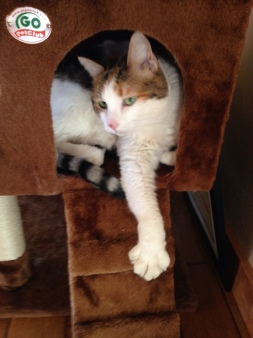Breeder of third generation Minuet and Minuet Tall cats, the pride of cat lovers, and the kings and queens of the cat world.


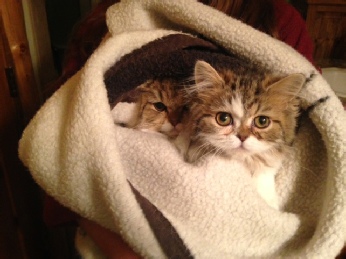 No matter what kind of cat you have–-
No matter what kind of cat you have–-
Short-
Short-
Minuets come in both long-
Short-
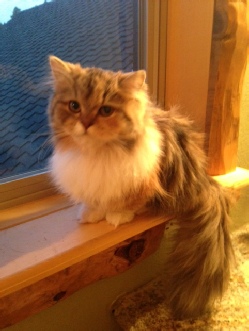 Long-
Long-
Long-
Some long-
Long-
See the following Hair Care section.
Hair Care
Every cat needs to have its coat addressed, no matter what the length. The time you spend on brushing or combing your cat is dependent on the length and thickness of its coat, and how much thickness you may want your cat’s coat to maintain.
Short-
Long-
Don’t forget your cat’s tail. If you have a long-
Mat removal: The best way to deal with mats is to prevent them from forming. That means daily grooming of your cat’s coat. However, if you end up with a mat, address it immediately with a metal comb. Use the end prong to pick the matted hair apart, holding the hair near the skin to reduce the pull on your cat. If you have a particularly nasty mat that is resistant to your comb, you can employ a seam ripper. The inner edge of the prong on a seam ripper is like a blade and can be used to cut through parts of the mat to break it up. However, use great care if you turn to this tool for help, as the tip can pierce your cat’s body if improperly used.
A severe mat may have to be cut out with scissors. This is the most risky endeavor you can turn to. A cat’s skin is extremely fragile and will cut easily. Make sure there is a lot of clearance between the mat and the skin before you attempt to cut it with scissors. Use the seam ripper to get that clearance before attempting to use the scissors.
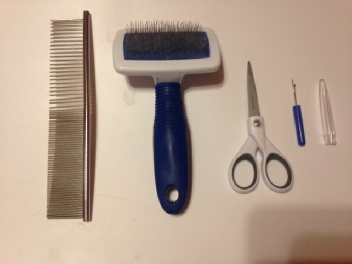
Basic grooming tools:
Metal comb (left), essential
Wire brush (second), minor
Scissors (third), necessary
Seam ripper (last), necessary for mats
Comb versus brush: I used to brush my long-
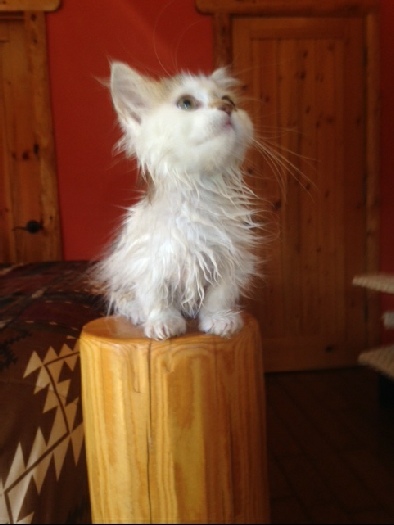
Bathing
Bathing your cat may seem like a daunting experience, but it is a necessary part of your cat’s grooming. No matter how clean you keep your cat, natural oils build up on its coat just like in your own hair. Shampooing your cat with a pet shampoo will return your cat’s coat to its natural lustrous state.
The best thing you can do for your cat is to start a bathing routine when she is a kitten. Start slowly, with a wet washcloth to introduce your kitten to being wet. When your kitten is okay with the idea of being wet, progress to a bathroom sink with a little water. Set your kitten in the water and use the washcloth to get her wet again. It’s not important to use shampoo at this point. Right now, you just want to get her use to being wet. She may be a little frightened, but talk soothingly to her. Take her out of the water if she is frantic. Re-
When your kitten is okay with being in the water, raise the level of the water to her chest and start with a little shampoo. Be careful not to get any on her face. You don’t want water to get in her nose or you might have to start all over again with her training.
Eventually, with this slow progression of training, you will get your cat to accept her bath. She may not like it but she won’t fight you on it.
Her bathing training doesn’t end with the bath. You’ll have to get her used to the blow-
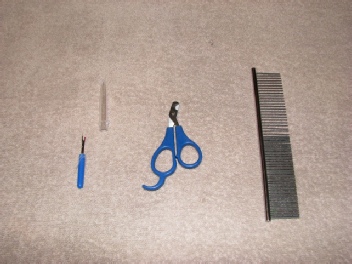 Nail Care
Nail Care
Let’s not forget your cat’s nails. Proper trimming of a cat’s claws will prevent damage to your furniture, accidental scratches, and pain for your cat if a nail grows into its pad. This is quite possible for your cat’s dew claws. Those are the “thumbs” on the cat’s front paws. They don’t connect with the ground, so they are not worn down by walking.
You should cut your cat’s claws every couple of weeks. You may think it to be another daunting exercise, left only to a professional groomer or the vet, but you can definitely learn how to do it yourself. The trick is to gain the confidence of your cat.
I work with all our kittens before they go home so they are used to their nails being clipped. Kitten claws are very painful, like hypodermic needles. And a kitten doesn’t know how to retract its claws until six or seven weeks of age. So clipping them is to your advantage.
I start to acclimate my kittens to nail clipping by pressing on each toe pad to squeeze out the nail. This is what you will be doing when you clip your cat’s nails. Don’t attempt to clip the nails until you can squeeze the pads without frightening your kitten. When you’ve reached that point, use a pair of pet nail clippers just to snip off the tip of the nail. Again, this is to acclimate your kitten to the process. Don’t risk getting too close to the pink part of the nail, which has blood and nerves in it and will be extremely painful for her if you cut into it.
When your kitten is used to the process of clipping the tips off, you can move up the curve of the nail and snip it off. This is all you need to take off to make the nail blunt.
Picture above: A single tool is necessary for taking care of your cat’s claws: the pet nail clipper (middle). This is essential for your grooming kit.
Eyes and Ears
Your cat’s eyes and ears shouldn’t be forgotten, although they are easily overlooked. Depending on the breed of cat, your pet’s eyes may water excessively. This should be treated with a tear-
Ears: Your cat’s ears will accumulate dirt over time. Even though you don’t believe it, you can clean your cat’s ears without much trouble. Use a cotton ball with water to wipe away the dirt. Particularly tricky spots might require alcohol on a cotton ball to break up the waxy film. Be careful not to go into the ear canal. Just like being warned not to use a Q-
Teeth
I cannot stress enough how important maintaining the health of your cat’s teeth are. Your cat’s mouth is subject to hoarding food particles in between the teeth and under the gum line. This develops bacteria that promotes gum disease and the deterioration of individual teeth. Proper cleaning is important to ensure that your cat keeps her teeth throughout her lifetime and has no health issues with her mouth.
You might laugh, but one of my daily chores is to brush our four dogs’ teeth. I’ve done this for years and always get complimented by the vet. However, they still need annual dental cleanings. Unfortunately, I cannot brush my cats’ teeth. A Minuet’s mouth is so small that even a baby toothbrush will not fit in between the teeth and cheeks. Yet I take my cats to the vet for their dental checkups and cleanings every year, or more often, depending on the vet’s recommendation.
A dental cleaning is not cheap but it is crucial. If your cat ends up with a dental disease–which is extremely possible if her teeth are ignored–you will be paying an astronomical amount to repair the damage. One thing I learned in maintaining dental care is that dental cleaning costs vary from vet to vet. Don’t let loyalty to your long-
Treats: The best treats you can give your cat are ones designed for “brushing” or “dental health.” These treats are designed to break up food particles and plague for the daily maintenance of your cat’s mouth. They are not to be used in lieu of a dental checkups and cleanings, but to limit the amount of work your vet might have to do during the cleaning. Remember, the less work your vet has to do in your cat’s mouth, the less expensive the bill will be, and the less pain your cat will have to endure afterward.
We use Greenies dental treats, which come in a variety of flavors. Our cats devour them.
Nutrition
Lastly, the topic of grooming your cat wouldn’t be complete without mentioning the need for proper nutrition. Your cat’s coat, teeth, and internal health are dependent on getting the best nutrition possible. Cats are carnivores and the primary ingredients in their food should be proteins, primarily meat proteins. Too many commercial foods have grains and by-
Treats: Remember to consider the ingredients of the treats you give your cat. Don’t feed your cat the best food possible and offset it with poorly balanced treats.
Note: Cats should not eat uncooked human-
